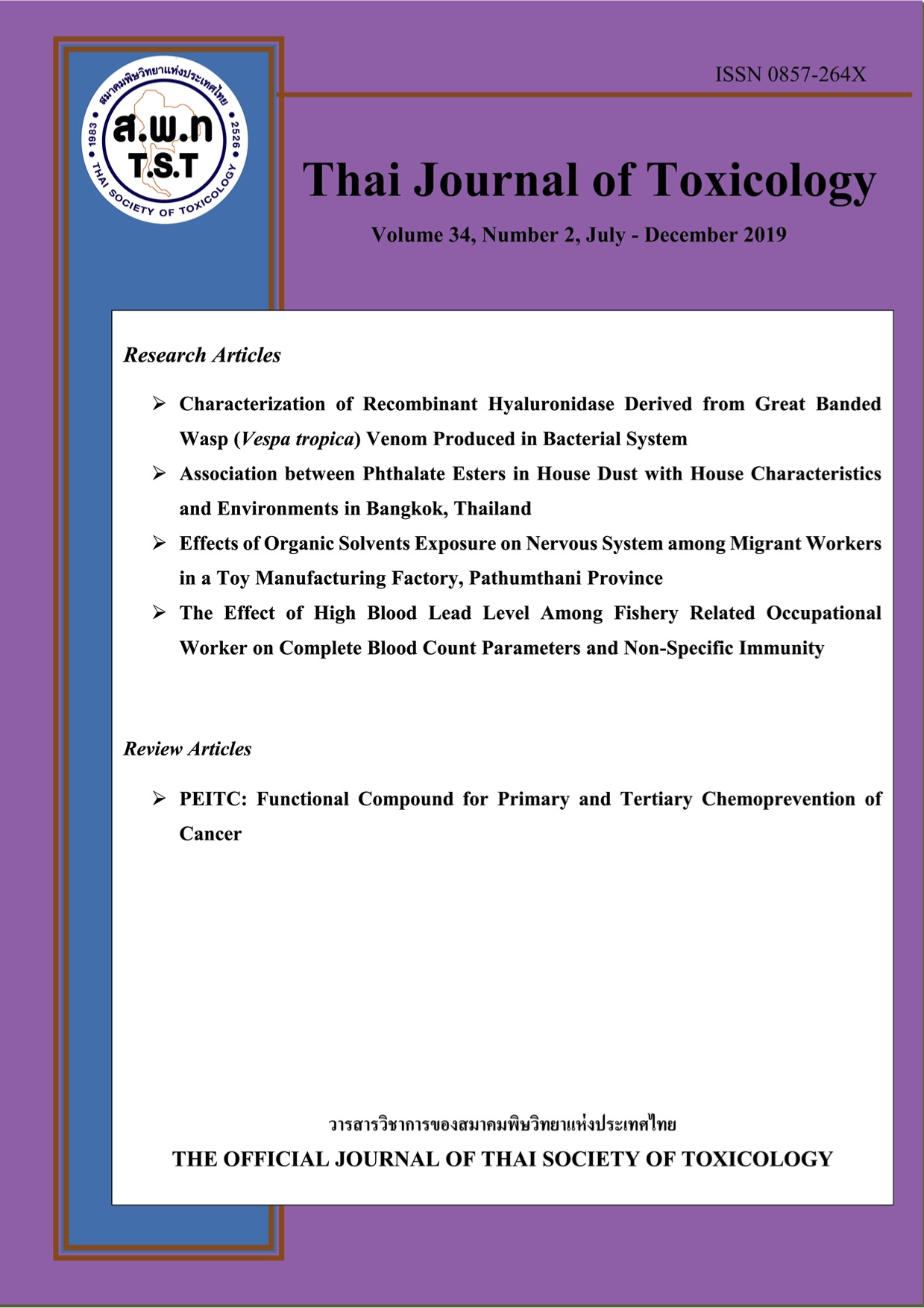คุณลักษณะของเอนไซม์ไฮยาลูโรไนเดสลูกผสมจากน้ำพิษตัวต่อหลุม (Vespa tropica) ที่ได้รับการผลิตในระบบแบคทีเรีย
Main Article Content
บทคัดย่อ
น้ำพิษต่อหลุม (Vespa tropica) ประกอบด้วยโมเลกุลที่มีฤทธิ์ทางชีวภาพ รวมทั้งเอนไซม์ไฮยาลูโรไนเดส (HAase) ที่มีฤทธิ์เร่งปฏิกิริยาการสลายด้วยน้ำของกรดไฮยาลูโรนิก งานวิจัยนี้ได้สังเคราะห์ยีนไฮยาลูโรไนเดสจาก cDNA ที่เตรียมจากต่อมพิษต่อหลุมด้วยเทคนิคพีซีอาร์ และสร้างสายพันธุ์กลายตำแหน่งเดียว (mHAase(N109L)) โดยแทนที่กรดอะมิโนตำแหน่งที่ 109 จากแอสพาราจีน (N) เป็นลิวซีน (L) ด้วยเทคนิคการกลายเฉพาะที่ นำชิ้นยีนเชื่อมกับ pET32a vector และถ่ายโอนเข้าสู่ E. coli BL21 กระตุ้นการแสดงออกด้วย 0.1 mM IPTG ที่อุณหภูมิ 18oC เวลา 16 ชั่วโมง ตรวจสอบการผลิตโปรตีนลูกผสมด้วยเทคนิคเจลอิเล็กโตรโฟริซิส พบแถบโปรตีนลูกผสม Re-HAase และ Re-mHAase(N109L) ขนาด 58 kDa และพบว่าโปรตีนลูกผสมไม่ละลายในบัฟเฟอร์ที่มีน้ำเป็นองค์ประกอบหลัก จึงคืนสภาพด้วยการละลายในยูเรีย 4 โมลาร์ แล้วทดสอบฤทธิ์การสลายกรดไฮยาลูโรนิกด้วยวิธีทดสอบความขุ่น พบว่าโปรตีนลูกผสมทั้งสองมีค่าพีเอชพอเหมาะในการเร่งการสลายกรดไฮยาลูโรนิกเท่ากับ 5 ซึ่ง Re-HAase มีฤทธิ์เอนไซม์ไฮยาลูโรไนเดสในช่วง pH 3 ถึง 6 แต่ Re-mHAase(N109L) มีฤทธิ์เอนไซม์ช่วง pH 5 ถึง 6 ฤทธิ์นี้ต่ำกว่า Re-HAase ประมาณร้อยละ 50 และไม่มีฤทธิ์ใด ๆ ที่ pH น้อยกว่า 4 โดยที่ Re-mHAase(N109L) มีฤทธิ์เอนไซม์ไฮยาลูโรไนเดสเหลืออยู่ คาดว่าเป็นเพราะกรดอะมิโนแอสพาราจีน (N) ทำหน้าที่เป็นตำแหน่งจับกับกรดไฮยาลูโรนิก แล้วมีกรดอะมิโนอื่นที่ทำหน้าที่เป็นกรดอะมิโนสำคัญที่ช่วยเร่งปฏิกิริยา


